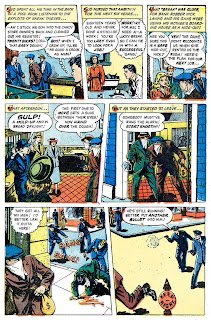
Number 1114
Bad blondes
Women didn't fare too well in pulp crime fiction or crime comic books of a bygone era; they were either on the covers being threatened in hideous ways by evil men, or inside being victims or victimizers (read: "bitches"). Women engaged in "normal" female activities were usually relegated to character rather than starring roles. Okay, I know that's a pretty broad statement. (Hyuk hyuk. Get it? Broad?) Maybe it's true or just my perception, having read a lot of crime comics and pulp crime fiction over the past half century.
The two blondes who both appeared in 1948's Pay-Off #1 meet the bitch specifications: they are manipulative and murderous. Murderous because they arrange for a killing, but manipulative in that they get someone else to do their dirty work. "The Guilty Conscience," drawn by Louis Schroeder, is even more blatant. Della, the gangster's girlfriend, uses the promise of sex (shown as a kiss and a flash of leg, plus her thought, "I've never seen a chump yet who wouldn't double-cross his own mother for a a pretty leg."*) She gets the youthful criminal wannabe, Jud Gibson, to ice-pick Nick Lavino to death.
In "Diamond Lil of Otsego," art by Bob Jenney, Lil gets her friend May to do the murder of the poor old caretaker for his life insurance. In this case the blonde gets another woman to do a murder, but May is a brunette.













 *True.
*True.















































